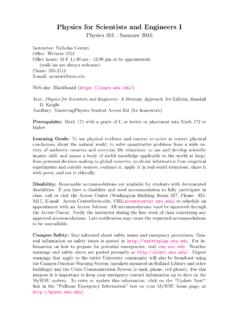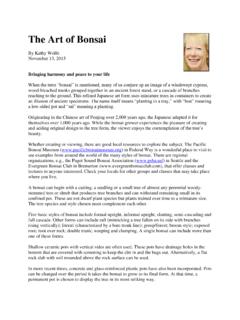Transcription of Judging Horses 101 - Washington State University
1 Judging Horses 101. By Amanda Kumiko Kent and Cindy A. Kinder Photo by Donna Gillespie Animal Selection Note Taking Terms & Transitions Oral Reasons Format Horse Selection Unlike livestock, which are judged for production purposes, Horses are looked at in terms of their athletic performance ability. To develop a strong foundation for horse Judging skills remember your A, B, C's: Action, Balance, Conformation A. Action Structure and Travel Just like different human The way an animal moves or its action is determined by its skeletal athletes, equine athletes need structure.
2 Correct structure is essential to prevent the development different body types to be the of unsoundness or lameness in a horse, which may result in poor best at different tasks. performance or the inability to perform. You can observe structure in: the angle of the shoulder, length of back in comparison to underline, level croup, pastern angle and leg set. Example: A sprinter (Quarter Horse). compared to a long distance runner (Thoroughbred). Or a ballerina (Arabian) vs. a football player (Clydesdale). Correct leg set equals durability. If a horse stands straight, it will probably travel straight.
3 If it stands crooked, it will travel crooked. Crooked movement wastes energy, can affect agility, and predisposes the horse to unsoundness. 1. Narrow, slightly knock- kneed *Try it yourself: keep toes pointed in 2. Base wide, pigeon toed' and walk four paces- toed-out How did that affect your movement? Now try pointing your toes out or 3. Straight legs, standing with legs wide apart. slightly toed-out 1 2 3. B. Balance Balance is uniformity in the appearance of muscle. This will vary slightly according to breed characteristics. Visualize three equal circles on the horse's body: one starting at the point of the shoulder and extending to the heartgirth, one just behind the heartgirth to the flank, and the last one at the flank to the point of the buttocks.
4 C. Conformation Breed Characteristics Conformation includes all aspects of the horse's What may be ideal' conformation for one body: muscling and balance, structural breed's purpose may serve no need or may smoothness, body proportions, overall appearance hinder another breed's performance. and ideal characteristics for sex and breed. Breed characteristics may include specific requirements of color and markings. Faulty or poor conformation would include an unsoundness or potential unsoundness or deviation from the ideal. Photo from American Quarter Horse Association Photo from Arabian Horse Association Photo from Fresian Horse Association Photo from the American Saddlebred Horse Assoc.
5 Why might these breeds have been developed? Note Taking Presenting oral reasons is the most valuable experience you will encounter in Judging . No matter what career you choose, to communicate effectively is a must to be successful. Success starts with note taking. In contests, several classes are judged in a short time, and oral reasons are given later; therefore it is necessary to take notes on what you see about the animals or performance in each class. Study the notes before giving oral reasons to a judge. A good set of notes should help you remember the class in your mind .
6 A 6 x9 steno notebook is suggested for use in taking notes. Only take notes on classes that have been assigned as a reasons class. Once animals are evaluated and placed notes are to be taken. The format for notes is broken down into three sections: 1. Top Pair (of animals). 2. Middle Pair (of animals). 3. Bottom Pair (of animals). Each section can then be further broken down into three pieces: Grant is to list one good quality of the lower placed animal in a pair Criticize is to list the bad qualities, one or two things, of the higher placed animal in the pair. Compare is to list two or three good qualities of the higher placed animal in the pair.
7 Below is what a blank note page should look like. Class Name _____ Class Placing _____. _____ Number and Grant (Good) Criticize (Bad) Compare (Good). identification _____ Number and Grant Criticize Compare Identification _____ Number and Grant Criticize Compare Identification _____ Number and Grant Criticize XX. Identification Notes should be readable and brief; this will prevent you from memorizing your notes. You should be able to remember the animals, not your notes. Below is what should be listed in your note page. Top Pair yellow highlighted sections are to be said for the top pair.
8 Middle Pair grey highlighted sections are to be said for the middle pair. Bottom Pair blue highlighted sections are to be said for the bottom pair. # of Animal Grant (Good) Criticize (Bad) Compare (Good). Opening statement Say any bad qualities Say why 1st place say why 1st place of the 1st place animal beats 2nd animal wins the class. animal. (optional) place animal by stating the good qualities of 1st place animal. Say the good qualities List why the 2nd place Say why 2nd place of the 2nd place animal does not win animal beats 3rd place animal over the 1st the class.
9 (bad animal by stating only place animal. qualities) the good qualities of the 2nd place animal. Say the good qualities Say why the 3rd place List why 3rd place of the 3rd place animal is 3rd. (bad animal beats 4th place animal over the 2nd qualities) animal by stating only place animal. the good qualities of the 3rd place animal. Say the good qualities Say why the 4th place of the 4th place animal animal is last. over the 3rd place animal. Tips for Effective Reasons Note taking and Reasons. 1. Don't start taking your notes until you have placed the class and written down your placing.
10 2. Try to be general in the terms that you use to describe the animal in each box, but write as much as possible to describe the animal. You will have time to be descriptive with the terms that you use when you prepare to deliver your oral reasons. 3. Don't forget to write down an ID point and sex, if needed, for each animal. 4. Be sure to use the correct sex of the animal in classes that are of mixed sex and use your ID points when describing the animals. 5. Use the time during non reasons classes to look back at your notes and prepare your reasons or complete your notes.








